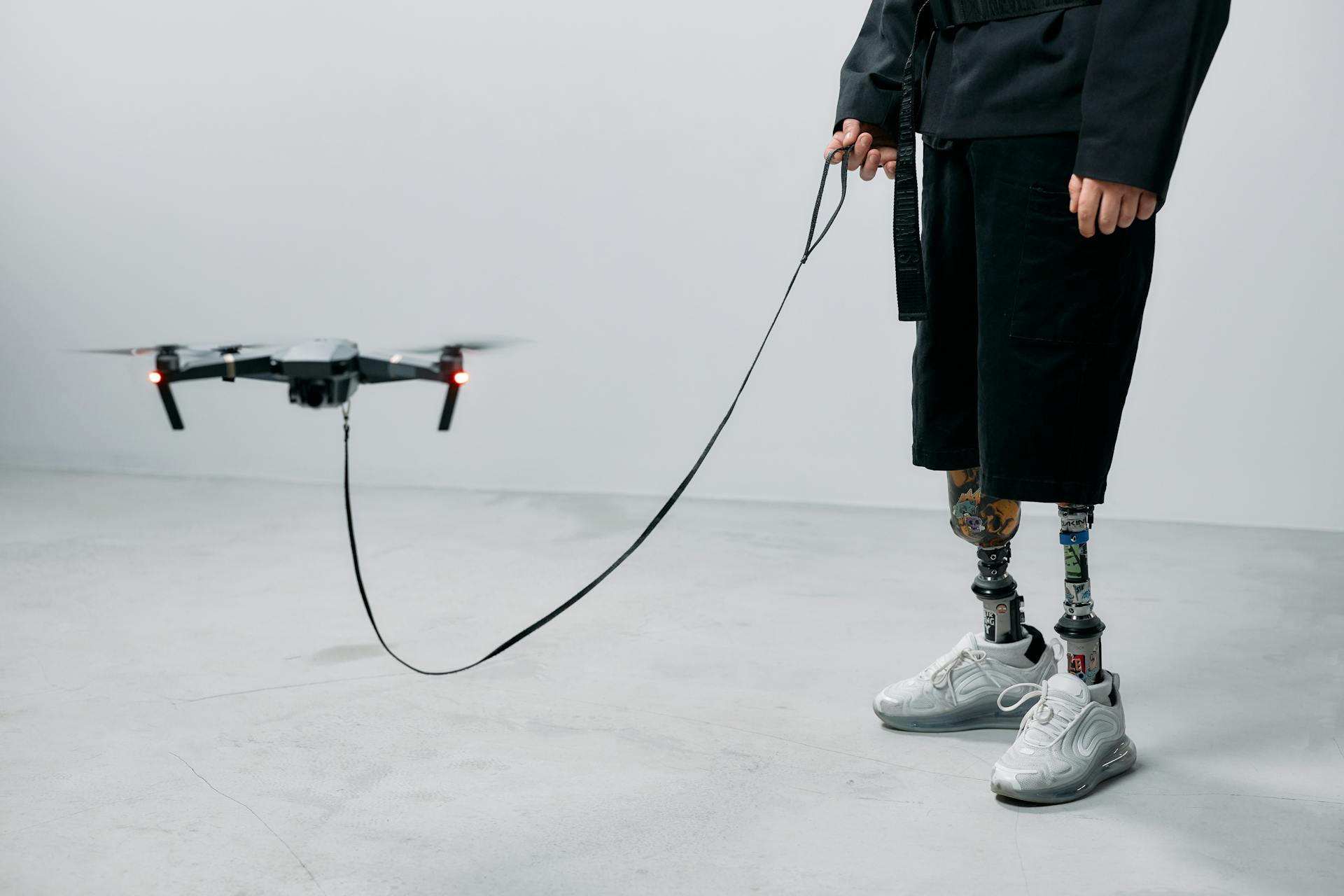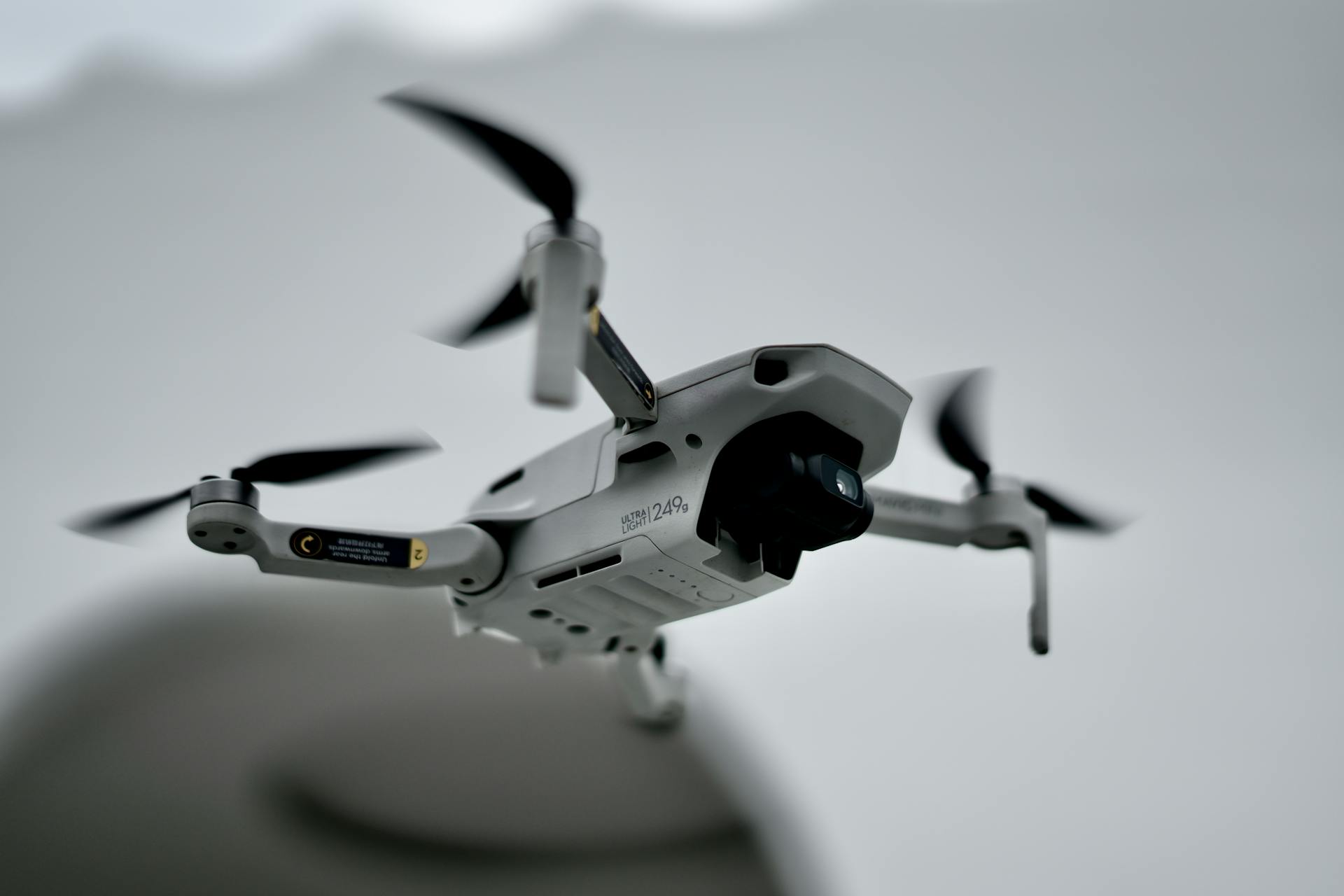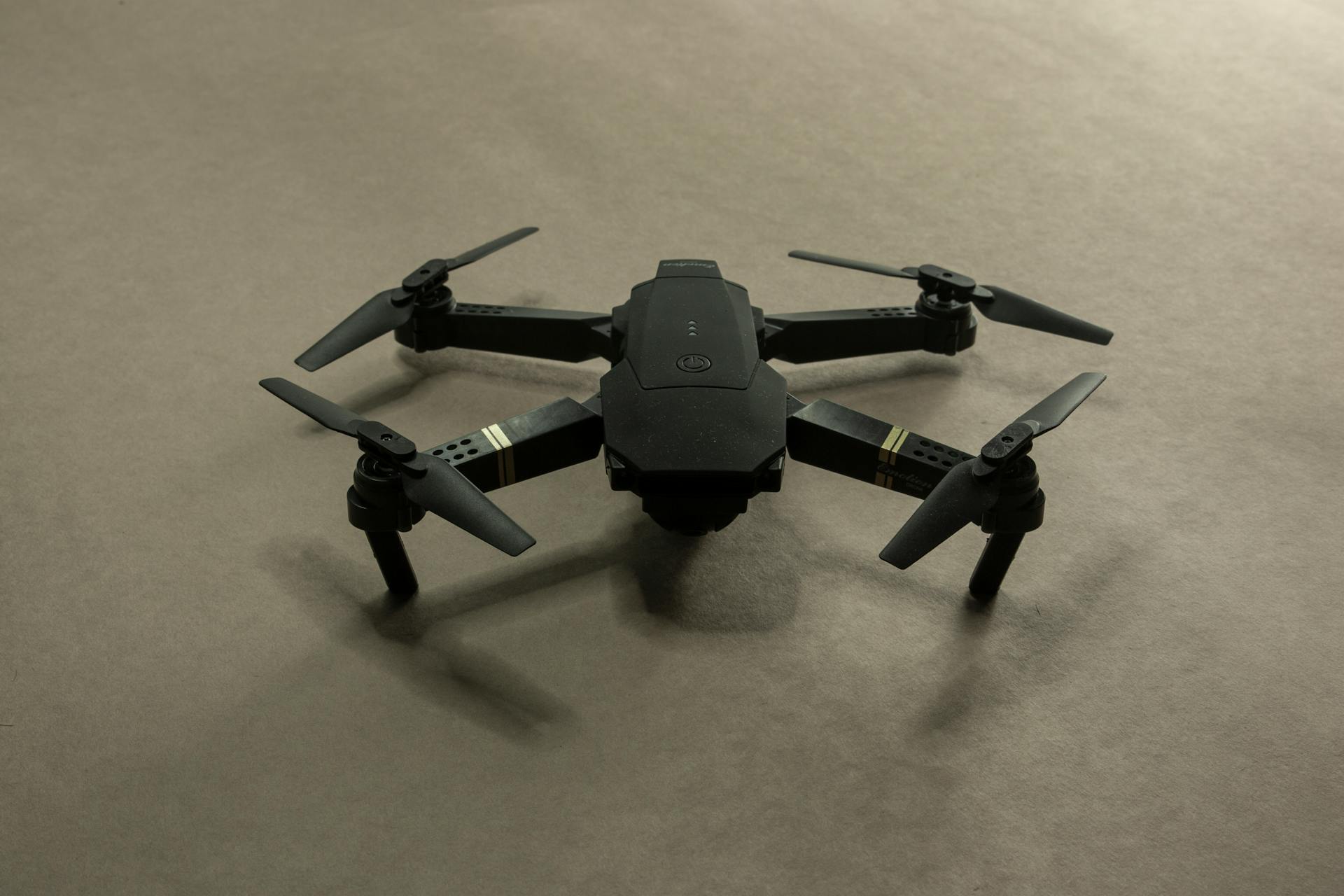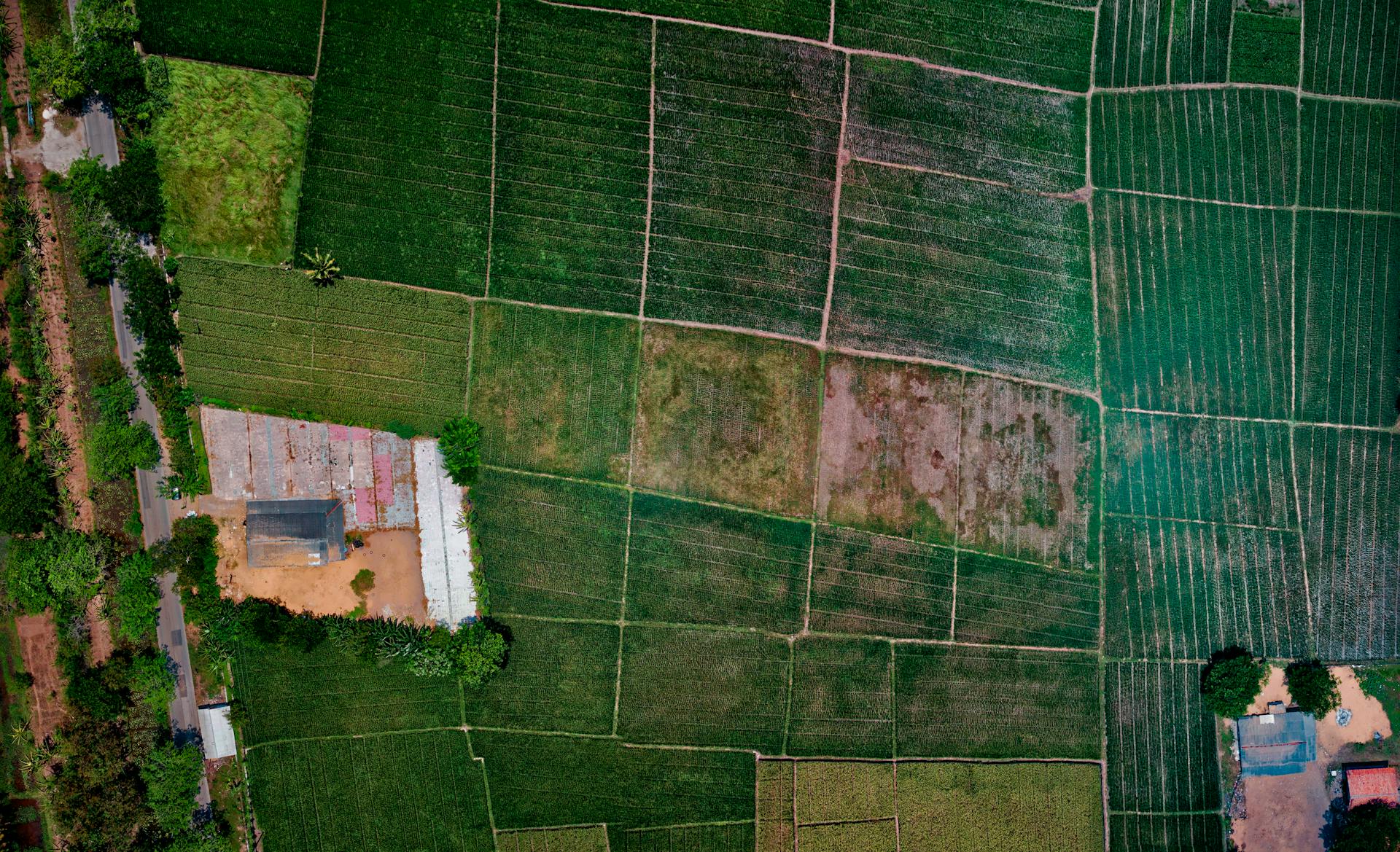
Military drone swarms are becoming increasingly sophisticated, with the ability to adapt to changing situations through swarm intelligence. This technology allows drones to work together, sharing information and making decisions in real-time.
Swarm intelligence is made possible by advanced algorithms that enable drones to communicate and coordinate their actions. For example, the "swarm behavior" of a group of 1,000 drones can be controlled by a single human operator.
The benefits of swarm intelligence are numerous, including increased mission effectiveness and reduced risk to human lives. In a swarm, drones can cover more ground and gather more information than a single drone ever could.
One notable example of swarm intelligence in action is the "Swarmathon" competition, where teams of researchers and engineers competed to develop the most advanced swarm algorithms.
Consider reading: Most Advanced Drone Military
What Are Military Drones?
Military drones are unmanned aerial vehicles (UAVs) used by military forces for various purposes.
They can be controlled remotely or programmed to fly autonomously, using GPS and sensors to navigate.
These drones can carry out surveillance, reconnaissance, and attack missions, providing real-time video feed and data to commanders.
They are typically smaller and more agile than manned aircraft, allowing them to access areas inaccessible to humans.
Drones can be equipped with various payloads, including cameras, sensors, and missiles.
Their use has revolutionized modern warfare, enabling military forces to gather intelligence and strike targets more effectively.
Some drones are designed for specific tasks, such as the MQ-9 Reaper for combat missions and the MQ-4C Triton for maritime surveillance.
Their development has also raised concerns about safety, security, and the ethics of using unmanned systems in combat.
Intelligence Gathering
A military drone swarm can gather intelligence by using its collective sensors to detect and track targets.
Each drone in the swarm can be equipped with a variety of sensors such as cameras, radar, and infrared sensors to gather information from different spectrums.
The drones can also use their sensors to detect and track multiple targets simultaneously, providing a comprehensive picture of the battlefield.
By working together, the drones can cover a large area and gather more information than a single drone could.
This allows the military to gather intelligence more quickly and efficiently, and make more informed decisions.
AI in Military Drone Swarms
A military drone swarm is a group of unmanned systems that can work together to achieve a goal, with each individual member determining its course of action to facilitate the overall objective.
The military has many purposes for drones, including reconnaissance and surveillance. A drone swarm can be a game-changer on the battlefield, allowing the military to gather more information and respond quickly to changing situations.
Drones can exceed their individual capabilities when combined in a swarm, making them a valuable asset for the U.S. military. However, they also represent a threat when utilized by enemies, as seen in recent attacks on U.S. bases in Jordan and Syria.
Recent developments in AI have further enhanced the capabilities of drones, making them more effective in a variety of applications. AI-driven features have improved drone performance, safety, and efficiency.
AI has improved autonomous navigation in drones, allowing them to avoid obstacles and make changes in real time based on their environment. This makes drones safer and more efficient for tasks like surveillance and monitoring.
AI can quickly process the significant data input that drones collect, producing actionable insights that can be used to make decisions. This is particularly useful in applications like agriculture, where AI can quickly survey aerial imagery and flag potential issues in crop health or yield.
Improved payload capabilities for AI-powered drones bring significant benefits, especially in conjunction with rapid data processing. This allows drones to more effectively transport and use cameras, sensors, and other payloads.
AI will continue to advance over time, paving the way for drones to become even more integral to operations in a wide variety of fields. This means that drones will become safer, more efficient, and more effective in the years to come.
Emergent Behavior
Emergent behavior is a fascinating aspect of military drone swarm technology. It's a phenomenon where complex systems exhibit behaviors that can't be predicted from their individual components.
Emergent behavior is a key focus of the Emergent Swarm project developed by Sentient Digital. This cognitive architecture models manned military systems combined with a swarm intelligence that models unmanned systems.
If this caught your attention, see: Unmanned Aircraft Systems Operations
The goal of Emergent Swarm is to explore the decentralized control of unmanned systems and reveal any emergent properties of human-robot warfighter integration. This can help improve current tactical doctrine.
Sentient Digital is at the forefront of artificial intelligence and takes pride in supporting warfighters to keep up with the developments in twenty-first century warfare.
Future of Military Drone Swarms
Military drone swarms are becoming increasingly sophisticated, with the ability to adapt to changing situations in real-time. This is achieved through advanced artificial intelligence algorithms that enable the drones to communicate and coordinate with each other.
The US military has been actively developing drone swarm technology, with the Army's Project Maven aiming to integrate AI into military operations. The project has already shown promising results, with AI-powered drones successfully identifying and tracking targets.
Drone swarms can be used for a variety of missions, including reconnaissance, surveillance, and even combat. They offer a significant advantage over traditional manned aircraft, with the ability to operate in areas that are difficult or impossible for humans to access.
The Chinese military has also been investing heavily in drone swarm technology, with reports suggesting they have developed a swarm of 1,000 drones that can be controlled by a single operator. This represents a significant escalation in the development of drone swarm capabilities.
Drone swarms can be equipped with a range of payloads, including cameras, sensors, and even missiles. This allows them to gather intelligence, conduct surveillance, or even engage targets in real-time.
The future of military drone swarms looks bright, with many experts predicting that they will become a key component of modern warfare. As the technology continues to evolve, we can expect to see even more advanced and sophisticated drone swarms being developed.
Hive Brain Concept
The Hive Brain Concept is a game-changer for military drone operations.
It allows for the handling of various drone types, including the Teal 2, which is used by the U.S. Army and has a flight time of 30 minutes.
The Teal 2 also features encrypted, jam-resistant communications and a control range of three miles.
The drone's best-in-class thermal imager makes it a valuable asset on the battlefield.
The Hive decouples the drone launch and recovery process from human labor, enabling the dramatic scaling up of drone operations.
Red Cat's partnership with Sentien Robotics is at the heart of the Hive Brain Concept.
Their collaboration aims to automate the drone launch and recovery process using robotic hardware and intelligence software.
The Hive features two versions: the Hive Expedition, which is mounted on the back of a vehicle, and the larger, towed Hive XL.
These robotic systems can significantly reduce the workload and increase the efficiency of drone operations.
The Hive Expedition is a compact and portable system, making it ideal for deployment in various environments.
Mixed
Mixed swarms are becoming increasingly effective in military operations. Experience from Ukraine shows the effectiveness of hunter-killer teams, where larger drones are deployed for long-range reconnaissance and smaller quadcopters get a close look.
A single mobile vehicle can control a team of different drones for different purposes. The Hive can handle a mixed team of drones, including larger drones for long-range reconnaissance and smaller drones for close-up inspection.
In Ukraine, small drone operations are currently carried out by hand, which comes with risks and is labor-intensive. It typically takes a team two to operate a drone, one doing the piloting and the other the preparation, recovery, and battery changes.
The Hive system enables a small unit to keep a large number of drones in the air. This makes it ideal for convoy protection or other mobile roles.
Readers also liked: Drone Mobile Dash Cam
Why We Wrote This
The development of military drone swarms raises serious ethical dilemmas around regulation and deployment.
Artificial intelligence-powered drone technology could change warfare, but it's unclear how to maintain ethics in a democratic state.
The Pentagon must overcome technological challenges while keeping ethics intact, a daunting task.
The proliferation of cheap drones in conflicts like Ukraine and the Middle East has sparked a scramble to perfect uncrewed vehicles that can plan and work together on the battlefield.
Researchers are applying AI and autonomy to lethal machines, raising questions about human control in modern combat.
The Defense Department updated its guidance last year to address AI autonomy in weapons, but it's unclear how much human oversight is necessary.
The possibility of completely autonomous weapons systems is concerning, especially if adversaries like China don't grapple with the same ethical decisions.
What Makes a
A military drone swarm is made more effective by recent developments in AI, which have enhanced its capabilities, performance, and safety. AI-driven features have improved the technology's efficiency, making it a more reliable option for the U.S. military.
Autonomous navigation is one area where AI has significantly improved drones. By leveraging AI algorithms, drones can now avoid obstacles and make changes in real-time based on their environment. This enables them to operate more safely and efficiently.
AI excels in rapid data processing, allowing it to analyze the significant data input that drones collect and quickly produce actionable insights. In agriculture, for instance, AI can quickly survey aerial imagery and flag potential issues in crop health or yield.
Improved payload capabilities for AI-powered drones bring significant benefits, especially in conjunction with rapid data processing. Advanced payload capabilities can allow drones to more effectively transport and use cameras, sensors, and other payloads.
Drone Swarm Analogy
A drone swarm is essentially a group of drones working together to achieve a goal, but each individual drone can take its own course of action to facilitate the overall objective.
As explained by George Matus, a handful of drones can defeat a battalion of armored vehicles before they even reach the front line. This is a significant shift in military strategy, similar to how the machine gun changed the face of war over a century ago.
The military has many uses for drones, including reconnaissance and surveillance, but they also represent a threat when utilized by enemies. Recently, a drone attack on a base in Jordan resulted in the death of three U.S. soldiers and injuring 40 people.
Drone swarms can become even more dangerous than a single drone, and it's crucial for the U.S. military to understand this threat and counteract it. This is why researchers are working to develop countermeasures to combat drone swarms.
The technology behind drone swarms is developing at a breakneck speed, even as researchers face challenges specific to the battlefield. As George Matus says, the front line is going to become majority automated, if not fully automated, in the near future.
Frequently Asked Questions
Did drones swarm a US military base?
Yes, drones were reportedly spotted swarming over Langley Air Force Base in Virginia, appearing in the sky about 45 minutes after sunset each night. The incident was first detailed in a report by the Wall Street Journal.
Sources
- https://sdi.ai/blog/military-drone-swarm-intelligence-explained/
- https://www.airandspaceforces.com/drone-swarms-new-threat-us-bases/
- https://mwi.westpoint.edu/swarm-clouds-on-the-horizon-exploring-the-future-of-drone-swarm-proliferation/
- https://www.forbes.com/sites/davidhambling/2024/05/16/hives-for-us-drone-swarms-ready-to-deploy-this-year/
- https://www.csmonitor.com/USA/Military/2024/0826/pentagon-drone-swarms-ai-ethics-china-russia
Featured Images: pexels.com


